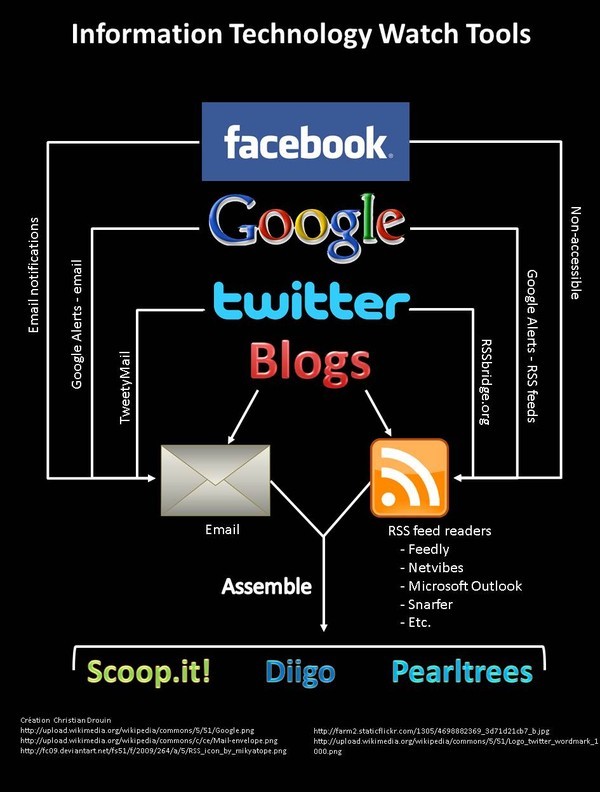Staying Informed Is Easy!
Text freely adapted into English with English resources by Norm Spatz of the Profweb Staff.
Today’s technology allows us to learn about any topic promptly. Therefore, continuing education for teachers can not only be achieved traditionally through means such as conferences or professional development days.
You can stay informed about two aspects of your professional life virtually:
- Developments in your discipline (to update your courses).
- Developments in teaching and pedagogy, including new technology (to optimize your teaching methods and knowledge about learning).
Where to start?
To help you keep abreast of developments in the world of education and in your discipline may I suggest an information technology watch mnemonic: EASY – Expand your network and select with care plus ASsemble information efficiently! (The ‘Y‘ is for efficiently.)
Expand Your Network and Select with Care
The first step is the establishment of an information network using existing connections. Have a Facebook account? There may be a Facebook group in your discipline. A good example is Cégep ESL Teachers. Additionally, passionate educators, such as Paul Murray have created sites which could be of interest. If you’d like to see a few back issues of his site, you can do so at http://www.paul-murray.org and once you’re there, if you like what you see, you can subscribe to his blog.
On Twitter, the microblogging site in 140 characters or less, there are incredible educators who share their discoveries and their realizations. If you do not know Twitter, they have a great support section. To find out who to follow on Twitter to start your day, try the search function using the keywords ‘information technology in education’. There is a great selection of corporate as well as individual tweeters.
Paul Murray, who was mentioned above, can also be followed on Twitter (@komox37) where at 9am, noon, and 3pm he posts a “best of” selection of the over 5000 educational sites that he’s archived during the last few years. Sites such as this allow educators to learn and contribute to the enrichment of their community.
Assemble Information
To gather information easily, I use two main methods – email subscriptions and RSS feeds.
Email Subscriptions
Subscription emails are sent by the vast majority of blogs, news sites and businesses. Subscribing to these newsletters is a very effective way to stay informed effortlessly. For example, an email subscription to the blog ESchool News or EClassroom News allows me to receive new articles on the integration of new technologies in education weekly.
It is also possible to receive an email whenever someone posts on Facebook groups that you follow. A web service like Google Alerts allows you to create automatic email alerts for each new publication identified by Google that matches your search criteria. Services like TweetyMail or TweetAlarm allow the same feature for Twitter.
RSS Feeds
As explained by Yves Munn in a column published in Profweb, RSS feeds are small text files from sources such as blogs, news sites or classifieds that are produced and updated automatically. You can subscribe to them and read them through software or web applications called “RSS aggregators”. Personally, I use Feedly (available for all platforms), but there are dozens more. One can even use Microsoft Outlook! An RSS feed from a locally based site with a global outlook on information technology in education is Dawsonite.
Every day, several items arrive at my favorite RSS aggregator without any effort on my part. I give them a glance when time permits, often on the bus! It is possible to subscribe to several RSS feeds at once using OPML files. Here are several OPML files containing feeds from websites or blogs related to education.
Both methods (Email subscriptions or RSS feeds) complement one another. Email is often easier to manage and consult. Who doesn’t look at email weekly or daily? And, RSS feeds allow us to consult online publications from thousands of sources of information offline without cluttering our email boxes!

Scoop.it, Diigo and Pearltrees can help you classify your information.
Assemble Information Efficiently
In order not to suffer from information overload, it is important to sort from time to time. Fortunately, many options exist, and you should try a few to find a solution that best meets your needs and tastes. To classify your emails, the easiest way is to move them into folders created inside your e-mail reader. There you can read your emails on a specific topic. For more elaborate tools providing web rankings, consider options such as Scoop It, Pearltrees and Diigo which permit saving, sorting and sharing web links.
Other Solutions
For other ways to monitor the world of education and the college network, take a look at the column by Geneviève Nault which highlights Isabelle Laplante, the librarian of the CDC (Centre de documentation collégiale) revealing some tips and multiple sources of information essential to remaining current with technological developments.
What strategies are you using to stay informed about developments in information technology? What resources have you found to stay leading edge in your field and in the study of education?


Hi Christian,
Congrats on your nice article! And thanks for mentioning Dawsonite, my weekly newsletter on Educational Technology.
Regards,